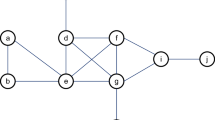Abstract
The spreading of information in network is different from epidemics in the population; meanwhile, the node is heterogeneous, and the structure is going in the direction of double or even multi-layer. It is of great practical significance to study the anti-risk capability of coupled network. Based on the subjective heterogeneity and memory effect heterogeneity, a two-layer SIR information propagation model is constructed and an important node selection method for the coupled network based on technique for order preference by similarity to an ideal solution (TOPSIS) is proposed. The effectiveness of the constructed model and the proposed method is verified by simulation experiment which selects the important nodes as the immune nodes of TOPSIS immunization strategy and adopts random immunization strategy, partial nodes immune layer strategy and TOPSIS immunization strategy on BA_BA, WS_WS and BA_WS coupled network. The experimental results show that subjective heterogeneity can hinder the dissemination of information, while the memory effect heterogeneity can facilitate the dissemination of information. In addition, different immune strategies have different effects on different coupled networks, for example, the TOPSIS immune strategy has the best effect in BA_BA network.















Similar content being viewed by others
References
Lao S, Wang J, Bai L (2016) Review of the interdependent networks. J Natl Univ Def Technol 1:122–128
Zhang X (2015) Multilayer networks science: concepts, theories and data. Complex Syst Complex Sci 12(02):103–107
Liu Z, Zhao S, Chen J, Zhang Y, Chen X (2017) A novel immune strategy based on node importance. J Nanjing Univ (Natural Sciences) 53(02):350–356
Buldyrev SV, Havlin S, Parshani R et al (2010) Catastrophic cascade of failures in interdependent networks. Nature 464(7291):1025
Zhao D, Wang L, Li S et al (2014) Immunization of epidemics in multiplex networks. PLoS ONE 9(11):e112018–e112018
Dickison M, Havlin S, Stanley HE (2012) Epidemics on interconnected networks. Phys Rev E Stat Phys Plasmas Fluids Relat Interdiscip Top 85(2):1380–1404
Zhang Y, Xu J (2015) A rumor spreading model considering the cumulative effects of memory. Discrete Dyn Nat Soc 2015:1–11
Du Y, Gao C, Hu Y et al (2014) A new method of identifying influential nodes in complex networks based on TOPSIS. Phys A: Stat Mech Appl 399:57–69
Qin L, Yang Z-L, Huang S-G (2015) Synthesis evaluation method for node importance in complex networks. Comput Sci 42(2):60–64
Han H, Yang R, Wang Z (2017) Risk propagation model of two-layer coupled networks under protection strategy. Syst Eng Electron 39(6):1298–1303
Wang J, Shi L, Wang Z (2018) Research on node importance ranking of multilayer network. Appl Res Comput 35(06):1742–1746
Wang G (2019) Small objects detection based on multi-scale feature fusion. Acta Microscopica 28(1):76–81
Du W, Li Y-Z, An X, Ma C-X (2016) A new class of two layers public traffic coupled network model. J Transp Syst Eng Inf Technol 16(4):131–138
Yang LS, Junde W, Liang B (2016) Review of interdependent networks. J Natl Univ Def Technol 1:122–128
Qin W, Fan T (2017) Modeling and analysis of information propagation model of online/offline network based on coupled network. In: Proceedings of Conference on Chinese Conference on Trusted Computing and Information Security, pp 16–25
Zeng J, Yang J, Chen Q (2016) Behavior of individual differences in human knowledge creation in the open source software community. Math Pract Theory 46(13):1–14
Zhu ZQ, Liu CJ, Wu JL et al (2014) The influence of human heterogeneity to information spreading. J Stat Phys 154(6):1569–1577
Zhang Z, Fan T (2014) Methods with immunization strategies popularity and node heterogeneity. J Hebei Acad Sci 31(02):90–93
Zhao W, Fan T, Nie Y, Wu F, Wen H (2018) Research on attribute dimension partition based on SVM classifying and MapReduce. Wirel Pers Commun 102(4):2759–2774
Zhao W, Yin Z, Fan T, Luo J (2019) Research on influence spread of scientific research team based on scientific factor quantification of big data. Int J Distrib Sens Netw. https://doi.org/10.1177/1550147719842158
Saaty TL (2008) Decision making with the analytic hierarchy process. Int J Serv Sci 1(1):83–98
Acknowledgements
The authors acknowledge the National Natural Science Foundation of China (Grant: 61373160), the Standardization Processing and Application System Development of Science and Technology’s Big Data (Grant: 17210113D) and Science and Technology Resource Survey, Statistical Analysis and System Development (Grant: 179676334D).
Author information
Authors and Affiliations
Corresponding author
Additional information
Publisher's Note
Springer Nature remains neutral with regard to jurisdictional claims in published maps and institutional affiliations.
Rights and permissions
About this article
Cite this article
Fan, T., Qin, W., Zhao, W. et al. A two-layer SIR information propagation model with heterogeneity based on coupled network. J Supercomput 76, 1657–1679 (2020). https://doi.org/10.1007/s11227-019-03020-3
Published:
Issue Date:
DOI: https://doi.org/10.1007/s11227-019-03020-3




